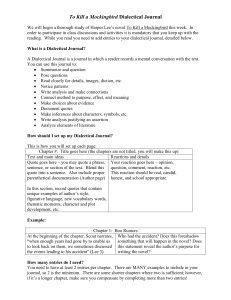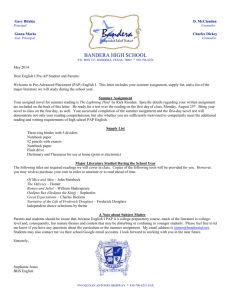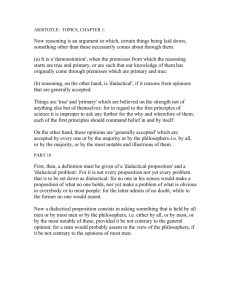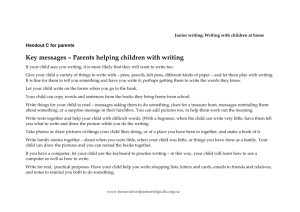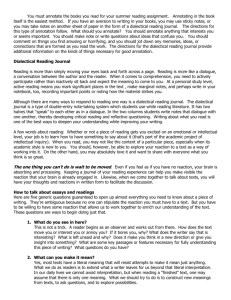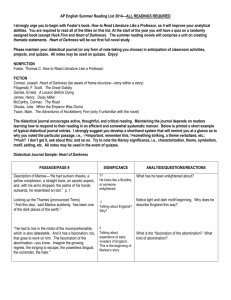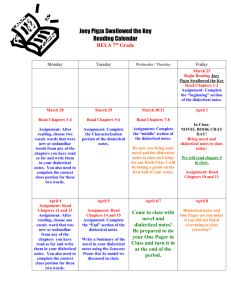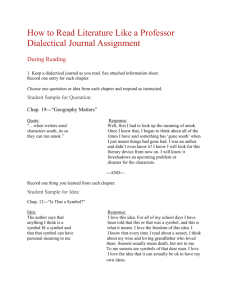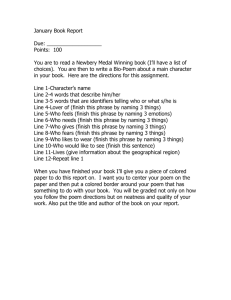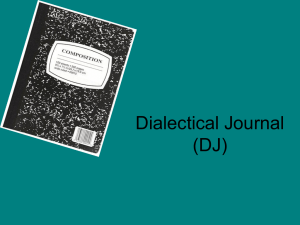Outside Reading Assignment Part I: The Dialectic Journal
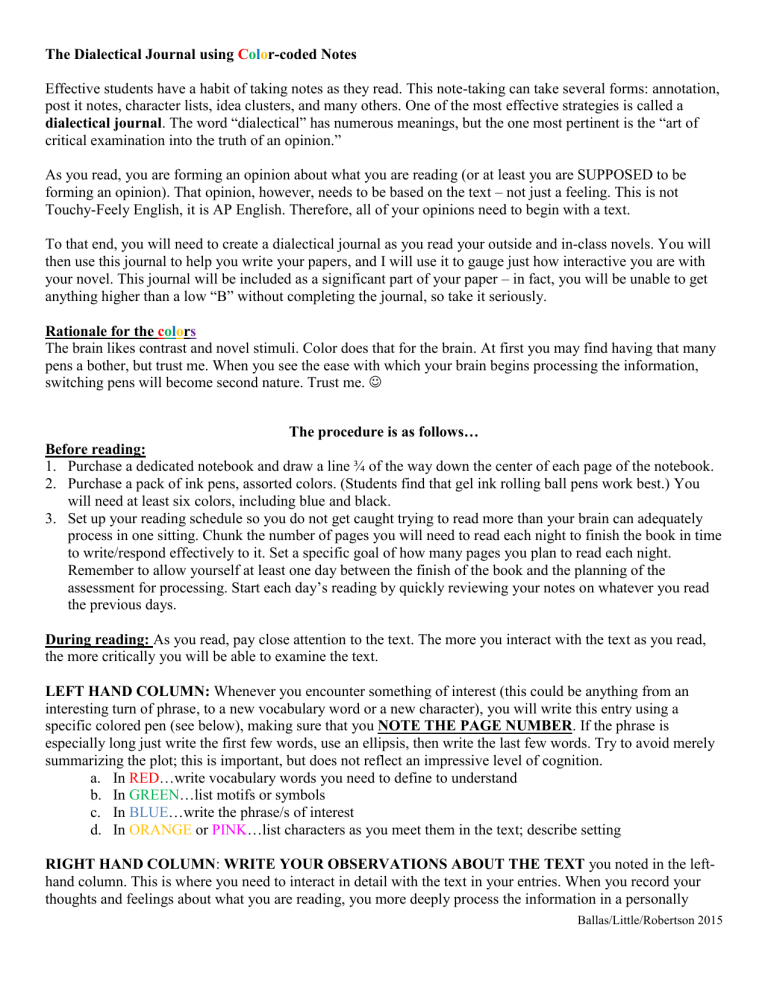
The Dialectical Journal using C o l o r-coded Notes
Effective students have a habit of taking notes as they read. This note-taking can take several forms: annotation, post it notes, character lists, idea clusters, and many others. One of the most effective strategies is called a dialectical journal
. The word “dialectical” has numerous meanings, but the one most pertinent is the “art of critical examination into the truth of an opinion.”
As you read, you are forming an opinion about what you are reading (or at least you are SUPPOSED to be forming an opinion). That opinion, however, needs to be based on the text – not just a feeling. This is not
Touchy-Feely English, it is AP English. Therefore, all of your opinions need to begin with a text.
To that end, you will need to create a dialectical journal as you read your outside and in-class novels. You will then use this journal to help you write your papers, and I will use it to gauge just how interactive you are with your novel. This journal will be included as a significant part of your paper – in fact, you will be unable to get anything higher than a low “B” without completing the journal, so take it seriously.
Rationale for the c o l o r s
The brain likes contrast and novel stimuli. Color does that for the brain. At first you may find having that many pens a bother, but trust me. When you see the ease with which your brain begins processing the information, switching pens will become second nature. Trust me.
The procedure is as follows…
Before reading:
1.
Purchase a dedicated notebook and draw a line ¾ of the way down the center of each page of the notebook.
2.
Purchase a pack of ink pens, assorted colors. (Students find that gel ink rolling ball pens work best.) You will need at least six colors, including blue and black.
3.
Set up your reading schedule so you do not get caught trying to read more than your brain can adequately process in one sitting. Chunk the number of pages you will need to read each night to finish the book in time to write/respond effectively to it. Set a specific goal of how many pages you plan to read each night.
Remember to allow yourself at least one day between the finish of the book and the planning of the assessment for processing. Start each day’s reading by quickly reviewing your notes on whatever you read the previous days.
During reading: As you read, pay close attention to the text. The more you interact with the text as you read, the more critically you will be able to examine the text.
LEFT HAND COLUMN: Whenever you encounter something of interest (this could be anything from an interesting turn of phrase, to a new vocabulary word or a new character), you will write this entry using a specific colored pen (see below), making sure that you NOTE THE PAGE NUMBER . If the phrase is especially long just write the first few words, use an ellipsis, then write the last few words. Try to avoid merely summarizing the plot; this is important, but does not reflect an impressive level of cognition.
a.
In RED
…write vocabulary words you need to define to understand b.
In GREEN
…list motifs or symbols c.
In BLUE …write the phrase/s of interest d.
In ORANGE or PINK
…list characters as you meet them in the text; describe setting
RIGHT HAND COLUMN : WRITE YOUR OBSERVATIONS ABOUT THE TEXT you noted in the lefthand column. This is where you need to interact in detail with the text in your entries. When you record your thoughts and feelings about what you are reading, you more deeply process the information in a personally
Ballas/Little/Robertson 2015
meaningful way. When you review some weeks or months later, these associations will help trigger memories of when you first saw the material, activating your context clues and your state dependent memory, insuring recall. Make sure that your observations are THOROUGH, INSIGHTFUL, and FOCUSED CLEARLY ON
THE TEXT . a.
In RED
…define, in your own words, to understand. If it is a word you know, but is being used in a new way, discuss why the author chose to use the word this way. b.
In GREEN
…what does the motif/symbol represent? c.
In BLUE
…why did you choose this phrase/quote? What is the author trying to show in this passage that you felt was important? d.
In ORANGE or PINK …describe characters and, most importantly, note when you see changes in the character. Why are these changes important? Describe setting (time and place) and any significant changes to setting throughout the novel. How is the author using setting or the time period? e.
In PURPLE
…question…question…question! This is the most important aspect of text interaction.
When you note a change or an interesting placement of a motif, ask “Why now…why here?” Leave room, so that when you understand the author’s purpose, you can write your insights/answers to your questions.
After reading: This is where it all comes together.
BOTTOM OF THE PAGE , where it is not divided in half, you will summarize. NOTE : You may continue the dividing line to the bottom of each page as you journal through a chapter; just write through the dividing line for summarizing at the end of each chapter. a.
In BLACK…After you finish reading a major section and/or whole chapter, sum up in a few sentences what you have learned… not what happened ! Include your own main insights and thoughts about what the author is showing you. Explore through different lenses.
That is all there is to it. This way, once you have read your text you will already have a great set of notes on which to draw when you write your paper. You also should have gained a great deal of insight about your particular text.
These will be scored for depth, accuracy, and effort. However, as with most things, you get out of it what you put into it. I know you are about the grade – I am about the learning. Therefore, the score is to satisfy your
“need” for a grade; the process is for your learning.
Ballas/Little/Robertson 2015
